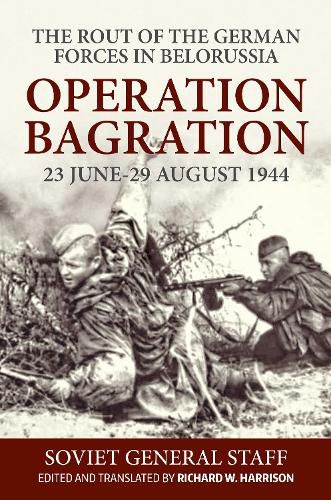Operation Bagration, 23 June-29 August 1944: The Rout Of The German Forces In Belorussia

Operation Bagration, 23 June-29 August 1944: The Rout Of The German Forces In Belorussia
The Rout of the German-Fascist Troops in Belorussia in 1944 covers the Red Army’s Belorussian strategic operation: the linchpin of the 10 major Soviet offensive efforts launched that year to clear the country of the invader. The Rout of the German-Fascist Troops in Belorussia in 1944 covers the Red Army’s Belorussian strategic operation: the linchpin of the 10 major Soviet offensive efforts launched that year to clear the country of the invader. During the course of this operation, the German position along the western strategic direction was destroyed and the stage was set for an advance into Poland and Germany. The success of this operation also set the stage for the Red Army’s subsequent advance into the Baltic and South-Eastern Europe. Like most works generated by the General Staff, the Belorussian study divides the operation into two parts: preparation and conduct. The first deals with the massive efforts by the First Baltic and the First, Second and Third Belorussian Fronts to accumulate the men and materiel to break through the German defenses in the swampy and forested terrain of Belorussia. This section contains valuable information on the overall correlation of forces, equipment and troops’ densities along the breakthrough sectors and Soviet plans for supplying the offensive, as well as detailed information regarding the employment of the various combat arms. The second part deals with the actual conduct of the several front operations that comprised the overall effort. This section covers the initial breakthrough battles and the encirclement of the Vitebsk and Bobruisk garrisons, followed by the capture of Minsk and the encirclement of sizeable German forces east of the city. The narrative then continues with the follow-on operations to cut off German forces in the Baltic States and to seize crossings over the Vistula River in Eastern Poland. Compiled and written by professional staff officers, this study provides a detailed look at the conduct of one of the major operations of the Second World War. This latest work, along with other studies in this series, offers another insight into the Red Army’s conduct of the war at the operational-strategic level. AUTHOR: Richard W. Harrison earned his undergraduate and master’s degrees from Georgetown University, where he specialized in Russian area studies. He later earned his doctorate in War Studies from King’s College London. He also was an exchange student in the former Soviet Union and spent several years living and working in post-communist Russia. Harrison has worked for the US Department of Defense as an investigator in Russia, dealing with cases involving POWs and MIAs. He has also taught Russian history and military history at the college and university level, most recently at the US Military Academy at West Point.Harrison is the author of two books dealing with the Red Army’s theoretical development during the interwar period: The Russian Way of War: Operational Art, 1904- 1940 (2001), and Architect of Soviet Victory in World War II: The Life and Theories of G.S. Isserson (2010). He is also the translator and editor of The Battle of Moscow 1941-1942: The Red Army’s Defensive Operations and Counter-Offensive Along the Moscow Strategic Direction (2015). He is currently working on a history of the Red Army’s high commands during World War II and afterwards. Dr. Harrison lives with his family near Carlisle, Pennsylvania.
This item is not currently in-stock. It can be ordered online and is expected to ship in approx 2 weeks
Our stock data is updated periodically, and availability may change throughout the day for in-demand items. Please call the relevant shop for the most current stock information. Prices are subject to change without notice.
Sign in or become a Readings Member to add this title to a wishlist.


